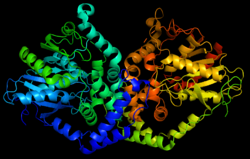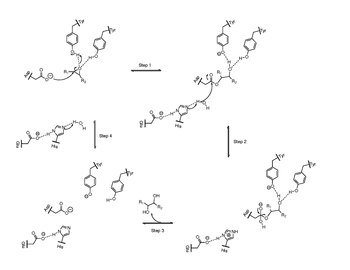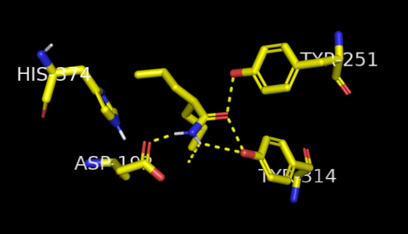Biology:Microsomal epoxide hydrolase
| Microsomal epoxide hydrolase | |||||||||
|---|---|---|---|---|---|---|---|---|---|
 A cartoon depiction of microsomal epoxide hydrolase from Aspergillus niger | |||||||||
| Identifiers | |||||||||
| EC number | 3.3.2.9 | ||||||||
| Databases | |||||||||
| IntEnz | IntEnz view | ||||||||
| BRENDA | BRENDA entry | ||||||||
| ExPASy | NiceZyme view | ||||||||
| KEGG | KEGG entry | ||||||||
| MetaCyc | metabolic pathway | ||||||||
| PRIAM | profile | ||||||||
| PDB structures | RCSB PDB PDBe PDBsum | ||||||||
| |||||||||
In enzymology, a microsomal epoxide hydrolase (mEH) (EC 3.3.2.9) is an enzyme that catalyzes the hydrolysis reaction between an epoxide and water to form a diol.

This enzyme plays a role in the uptake of bile salts within the large intestine. It functions as a Na+ dependent transporter. This enzyme participates in metabolism of xenobiotics by cytochrome p450. mEH has been identified as playing a large role in the detoxification and bioactivation of a wide variety of substrates, such as polycyclic aromatic hydrocarbons (PAHs), which are known for their carcinogenic properties.[1]
The human homolog of microsomal epoxide hydrolase is EPHX1 and is located on chromosome 1.[2]
Nomenclature
This enzyme belongs to the family of hydrolases, specifically those acting on ether bonds (ether hydrolases). The systematic name of this enzyme class is cis-stilbene-oxide hydrolase. Other names in common use include epoxide hydratase (ambiguous), microsomal epoxide hydratase (ambiguous), epoxide hydrase, microsomal epoxide hydrase, arene-oxide hydratase (ambiguous), benzo[a]pyrene-4,5-oxide hydratase, benzo(a)pyrene-4,5-epoxide hydratase, aryl epoxide hydrase (ambiguous), cis-epoxide hydrolase, and mEH.
Structure
Microsomal epoxide hydrolase is a single polypeptide chain composed of 455 amino acids with a molecular weight of 52.96 kilodaltons. It is known that the N-terminal region of the enzyme is responsible for anchoring the protein to the cell membrane,[3] while the C-terminal region of the enzyme contains catalytic residues.[4] Microsomal epoxide hydrolase belongs to the superfamily α/β-hydrolase fold enzymes.[5] The center of all α/β-hydrolase fold enzymes is an alpha/beta-sheet consisted of 8 beta strands connected by 6 alpha helices.[6][7] The three dimensional structure of mEH has been elucidated from Aspergillus niger.[4] Although no 3D modeling has been solved for the mammalian mEH enzyme (EPHX1), the overall homology between fungal and mammalian mEH is relatively high.[8][9][10] This high homology has allowed for the elucidation overall general structure and subsequent catalytic mechanism of EPHX1 in humans by comparisons to existing structures of fungal mEH.
Mechanism
α/β-hydrolase fold enzymes use a catalytic triad in their active site. The catalytic triad present in microsomal epoxide hydrolase is composed of glutamine, histidine and aspartic acid.[10] The substrate is positioned in an orientation poised for nucleophilic attack through hydrogen bonding stabilization from two nearby tyrosine residues [11][12] The proposed mechanism for the mEH-catalyzed reaction first involves a nucleophilic attack on the oxirane ring of the substrate from the aspartic acid residue near the active site, which forms an ester intermediate.[13] The second step in this mechanism is hydrolysis of the ester that occurs by an activated water molecule.[14] The activation of water is facilitated by proton abstraction via the catalytic triad between a water molecule, glutamine, and histidine.[15] After hydrolysis, the substrate is then released from its bond to the aspartic acid residue, liberating the diol product from the enzyme active site.[16]

The active site of this enzyme lies within a hydrophobic pocket in the enzyme, which in turn leads to the enzyme's preferential reactivity with molecules with hydrophobic side-chains.[17][11] The mEH enzyme typically binds to small organic epoxides, such as styrene epoxide and cis-stillbene-oxide. mEH does not catalyze the hydrolysis of bulkier molecules, as their large side-chains may sterically disrupt the charge relay system responsible for water activation.[11]

Function
In humans, mEH has been found in the ovary, lung, kidney, lymphocytes, epithelial cells, and liver.[18] Microsomal epoxide hydrolase serves as a protective enzyme against potentially harmful small molecules derived from the external environment.[19] This hydrolysis of genotoxic epoxides causes subsequent effects in several signal transduction pathways, rendering this enzyme important to metabolism.[20][21]
Disease relevance
Microsomal epoxide hydrolase plays a large role in its effects on human health. Studies have shown that mutations EPHX1 in humans may be the cause of hypercholanemia,[22] preeclampsia,[23][24] and may contribute to fetal hydantoin syndrome.[25] Research also suggests that maternal polymorphisms in EPHX1 in pregnant women were related to facial malformations of children born from women taking phenytoin during their first trimester of pregnancy.[26] While mEH participates in the protection of human health via detoxification of various environmental substances, it also has been found to facilitate the activation of carcinogens.[1]
mEH detoxifies reactive epoxides that are commonly caused from cigarette smoke, and as such it is hypothesized that mutations in EPHX1 in humans may have an effect on an individual's susceptibility to COPD, emphysema and lung cancer. Some sources have demonstrated that individuals affected by COPD have a higher rate of containing an under-active variant of the EPHX1 gene, yet also demonstrated that the overactive variant of the gene was also found in higher frequencies in individuals affected by disease as well.[27][28] Other research has provided evidence supporting the idea that EPHX1 variants do not contribute to susceptibility of disease, but do contribute to disease severity.[1] The role that mEH plays in lung cancer and COPD is still not fully elucidated, as the data on the topic in the literature is not completely unanimous.[29]
There is some evidence that mEH variants may contribute to the occurrence of childhood asthma in combination with variants on the GSTP1 gene.[30]
Compared to soluble epoxide hydrolase, the contribution of mEH to metabolism of beneficial epoxy fatty acids such as Epoxyeicosatrienoic acid is considered minor since they are relatively poor mEH substrates in vitro. Yet, in vivo, it was found that mEH can play a considerable role in regulation of EET levels[31][32] and hence inhibition of mEH or dual inhibition of mEH and sEH might have therapeutic potential. Amide, amine and urea based mEH inhibitors have been explored.[33] Based on the most potent inhibitors characterized, an amide with a bulky alpha-substituent and a phenyl ring with lipophilic groups at meta-positions appear to be key pharmacophore units.[34]
The overall effect that mEH has on human health is still debated, with some sources finding evidence that the overactive EPHX1 gene is the culprit for some diseases, while other evidence supports that the under active variant is the cause of others.
References
- ↑ 1.0 1.1 1.2 "EPHX1 polymorphisms and the risk of lung cancer: a HuGE review". Epidemiology 17 (1): 89–99. January 2006. doi:10.1097/01.ede.0000187627.70026.23. PMID 16357600.
- ↑ "Nucleotide and deduced amino acid sequence of human liver microsomal epoxide hydrolase". Nucleic Acids Research 15 (17): 7188. September 1987. doi:10.1093/nar/15.17.7188. PMID 3502697.
- ↑ "Membrane topology of epoxide hydrolase". Biochimica et Biophysica Acta (BBA) - Lipids and Lipid Metabolism 1046 (1): 32–9. August 1990. doi:10.1016/0005-2760(90)90091-B. PMID 2397243.
- ↑ 4.0 4.1 4.2 PDB: 3G0I; "Structure of Aspergillus niger epoxide hydrolase at 1.8 A resolution: implications for the structure and function of the mammalian microsomal class of epoxide hydrolases". Structure 8 (2): 111–22. February 2000. doi:10.1016/S0969-2126(00)00087-3. PMID 10673439.
- ↑ "The α/β hydrolase fold. Protein Engineering, Design and Selection.". Protein Eng. 5 (3): 197–211. April 1992. doi:10.1093/protein/5.3.197. PMID 1409539. https://pure.rug.nl/ws/files/3321987/1992ProteinEngOllis.pdf.
- ↑ "The alpha/beta hydrolase fold". Protein Engineering 5 (3): 197–211. April 1992. doi:10.1093/protein/5.3.197. PMID 1409539. https://pure.rug.nl/ws/files/3321987/1992ProteinEngOllis.pdf.
- ↑ "Alpha/beta hydrolase fold: an update". Protein and Peptide Letters 16 (10): 1137–48. 2009. doi:10.2174/092986609789071298. PMID 19508187.
- ↑ Arand, Michael; Oesch, Franz (2002-02-14). Mammalian Xenobiotic Epoxide Hydrolases. John Wiley & Sons, Ltd. pp. 459–483. doi:10.1002/0470846305.ch12. ISBN 9780470846308.
- ↑ "Cloning and molecular characterization of a soluble epoxide hydrolase from Aspergillus niger that is related to mammalian microsomal epoxide hydrolase". The Biochemical Journal 344 (1): 273–80. November 1999. doi:10.1042/0264-6021:3440273. PMID 10548561.
- ↑ 10.0 10.1 10.2 "Catalytic triad of microsomal epoxide hydrolase: replacement of Glu404 with Asp leads to a strongly increased turnover rate". The Biochemical Journal 337 (1): 37–43. January 1999. doi:10.1042/0264-6021:3370037. PMID 9854022.
- ↑ 11.0 11.1 11.2 11.3 "Molecular modelling of human microsomal epoxide hydrolase (EH) by homology with a fungal (Aspergillus niger) EH crystal structure of 1.8 A resolution: structure-activity relationships in epoxides inhibiting EH activity". Toxicology in Vitro 19 (4): 517–22. June 2005. doi:10.1016/j.tiv.2004.07.001. PMID 15826809.
- ↑ 12.0 12.1 "Structural insights into human microsomal epoxide hydrolase by combined homology modeling, molecular dynamics simulations, and molecular docking calculations". Proteins 85 (4): 720–730. April 2017. doi:10.1002/prot.25251. PMID 28120429.
- ↑ 13.0 13.1 "The catalytic mechanism of microsomal epoxide hydrolase involves an ester intermediate". Journal of the American Chemical Society 115 (22): 10466–10467. November 1993. doi:10.1021/ja00075a115.
- ↑ "Partitioning and Enhanced Self-Assembly of Actin in Polypeptide Coacervates". Biophysical Journal 114 (7): 1636–1645. April 2018. doi:10.1016/j.bpj.2018.02.020. PMID 29642033. Bibcode: 2018BpJ...114.1636M.
- ↑ "Metabolic detoxification: implications for thresholds". Toxicologic Pathology 28 (3): 382–7. May 2000. doi:10.1177/019262330002800305. PMID 10862554.
- ↑ "Directed evolution of an enantioselective epoxide hydrolase: uncovering the source of enantioselectivity at each evolutionary stage". Journal of the American Chemical Society 131 (21): 7334–43. June 2009. doi:10.1021/ja809673d. PMID 19469578. http://urn.kb.se/resolve?urn=urn:nbn:se:uu:diva-130672.
- ↑ "Microsomal epoxide hydrolase 1 (EPHX1): Gene, structure, function, and role in human disease". Gene 571 (1): 1–8. October 2015. doi:10.1016/j.gene.2015.07.071. PMID 26216302.
- ↑ Bachmann, Kenneth (2009). "Chapter 8: Drug Metabolism". Pharmacology. Elsevier. pp. 131–173. doi:10.1016/b978-0-12-369521-5.00008-7. ISBN 978-0-12-369521-5.
- ↑ "Mammalian epoxide hydrases: inducible enzymes catalysing the inactivation of carcinogenic and cytotoxic metabolites derived from aromatic and olefinic compounds". Xenobiotica; the Fate of Foreign Compounds in Biological Systems 3 (5): 305–40. May 1973. doi:10.3109/00498257309151525. PMID 4584115.
- ↑ "Leukotrienes and lipoxins: structures, biosynthesis, and biological effects". Science 237 (4819): 1171–6. September 1987. doi:10.1126/science.2820055. PMID 2820055. Bibcode: 1987Sci...237.1171S.
- ↑ "Bioactivation of leukotoxins to their toxic diols by epoxide hydrolase". Nature Medicine 3 (5): 562–6. May 1997. doi:10.1038/nm0597-562. PMID 9142128.
- ↑ "Inhibition of human m-epoxide hydrolase gene expression in a case of hypercholanemia". Biochimica et Biophysica Acta (BBA) - Molecular Basis of Disease 1638 (3): 208–16. July 2003. doi:10.1016/s0925-4439(03)00085-1. PMID 12878321.
- ↑ "Protein carbonyls in decidua and placenta of pre-eclamptic women as markers for oxidative stress". Placenta 22 (2–3): 213–9. February 2001. doi:10.1053/plac.2000.0606. PMID 11170826.
- ↑ "Two exonic single nucleotide polymorphisms in the microsomal epoxide hydrolase gene are jointly associated with preeclampsia". European Journal of Human Genetics 10 (9): 569–73. September 2002. doi:10.1038/sj.ejhg.5200849. PMID 12173035.
- ↑ "Prenatal prediction of risk of the fetal hydantoin syndrome". The New England Journal of Medicine 322 (22): 1567–72. May 1990. doi:10.1056/NEJM199005313222204. PMID 2336087.
- ↑ "Maternal EPHX1 polymorphisms and risk of phenytoin-induced congenital malformations". Pharmacogenetics and Genomics 20 (1): 58–63. January 2010. doi:10.1097/fpc.0b013e328334b6a3. PMID 19952982.
- ↑ "Association between polymorphism in gene for microsomal epoxide hydrolase and susceptibility to emphysema". Lancet 350 (9078): 630–3. August 1997. doi:10.1016/s0140-6736(96)08061-0. PMID 9288046.
- ↑ "Genetic association between COPD and polymorphisms in TNF, ADRB2 and EPHX1". The European Respiratory Journal 27 (4): 682–8. April 2006. doi:10.1183/09031936.06.00057005. PMID 16585076.
- ↑ Postma, Dirkje S.; Silverman, Edwin K. (2009). "Chapter 4 - Genetics of Asthma and COPD". Genetics of Asthma and COPD. Elsevier. pp. 37–51. doi:10.1016/b978-0-12-374001-4.00004-3. ISBN 9780123740014.
- ↑ "Microsomal epoxide hydrolase, glutathione S-transferase P1, traffic and childhood asthma". Thorax 62 (12): 1050–7. December 2007. doi:10.1136/thx.2007.080127. PMID 17711870.
- ↑ "Distribution of Soluble and Microsomal Epoxide Hydrolase in the Mouse Brain and Its Contribution to Cerebral Epoxyeicosatrienoic Acid Metabolism". Neuroscience 163 (2): 646–661. June 2009. doi:10.1016/j.neuroscience.2009.06.033. PMID 19540314.
- ↑ "Epoxide hydrolase 1 (EPHX1) hydrolyzes epoxyeicosanoids and impairs cardiac recovery after ischemia". The Journal of Biological Chemistry 293 (9): 3281–3292. January 2018. doi:10.1074/jbc.RA117.000298. PMID 29298899.
- ↑ "Inhibition of Microsomal Epoxide Hydrolases by Ureas, Amides, and Amines". Chemical Research in Toxicology 14 (4): 409–415. April 2001. doi:10.1021/tx0001732. PMID 11304129.
- ↑ "Development of potent inhibitors of the human microsomal epoxide hydrolase". European Journal of Medicinal Chemistry 193: 112206. March 2020. doi:10.1016/j.ejmech.2020.112206. PMID 32203787.
Further reading
- The Enzymes. 7 (3rd ed.). New York: Academic Press. 1972. pp. 199–212.
- "Liver microsomal expoxide hydrase. Solubilization, purification, and characterization". The Journal of Biological Chemistry 250 (20): 8283–8. October 1975. doi:10.1016/S0021-9258(19)40848-X. PMID 240858.
- "Purification and specificity of a human microsomal epoxide hydratase". The Biochemical Journal 139 (1): 77–88. April 1974. doi:10.1042/bj1390077. PMID 4463951.
- "Solubilization, purification, and properties of a hepatic epoxide hydrase". Biochimica et Biophysica Acta (BBA) - Enzymology 227 (3): 692–7. March 1971. doi:10.1016/0005-2744(71)90018-0. PMID 4998715.
- "Kinetics and stereochemistry of the microsomal epoxide hydrolase-catalyzed hydrolysis of cis-stilbene oxides". Chirality 6 (7): 577–82. 1994. doi:10.1002/chir.530060711. PMID 7986671.
- "Epoxide hydrolases: mechanisms, inhibitor designs, and biological roles". Annual Review of Pharmacology and Toxicology 45: 311–33. 2005. doi:10.1146/annurev.pharmtox.45.120403.095920. PMID 15822179.
- "Epoxide hydrolases: biochemistry and molecular biology". Chemico-Biological Interactions 129 (1–2): 41–59. December 2000. doi:10.1016/S0009-2797(00)00197-6. PMID 11154734.
- "Mammalian epoxide hydrases: inducible enzymes catalysing the inactivation of carcinogenic and cytotoxic metabolites derived from aromatic and olefinic compounds". Xenobiotica; the Fate of Foreign Compounds in Biological Systems 3 (5): 305–40. May 1973. doi:10.3109/00498257309151525. PMID 4584115.
- "Microsomal and soluble epoxide hydrolases are members of the same family of C-X bond hydrolase enzymes". Chemical Research in Toxicology 7 (2): 121–4. 1994. doi:10.1021/tx00038a001. PMID 8199297.
- "Epoxide hydrolases: their roles and interactions with lipid metabolism". Progress in Lipid Research 44 (1): 1–51. January 2005. doi:10.1016/j.plipres.2004.10.001. PMID 15748653.
 |

